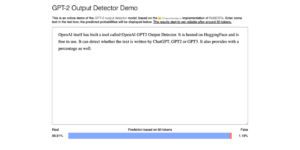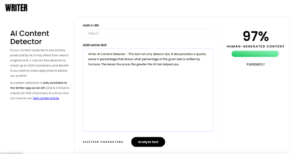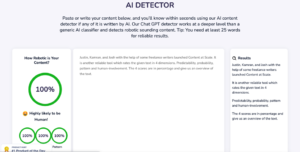From the invention of the calculator to computers to the present AI era, we humans have come a long way. Aka AI. In the simplest words, Artificial Intelligence is a set of algorithms/logic mimicking the human thought process and behavior. It simplifies and speeds up our work. One such AI tool that is making headlines is “ChatGPT.”
What is ChatGPT?
Open AI, the inventor, defines ChatGPT as “Introducing ChatGPT – We’ve trained a model called ChatGPT which interacts in a conversational way. The dialogue format makes it possible for ChatGPT to answer follow-up questions, admit its mistakes, challenge incorrect premises, and reject inappropriate requests.”
To Explain It Better
ChatGPT is an innovative AI-powered chatbot that has revolutionized the way people interact with technology. It is a conversational agent that uses natural language processing (NLP) to understand and respond to user queries. ChatGPT is built on top of the GPT (Generative Pre-trained Transformer) architecture, which is a state-of-the-art language model developed by OpenAI.
One of the key advantages of ChatGPT is its ability to understand and respond to complex queries. Unlike traditional chatbots that rely on pre-defined rules and scripts, ChatGPT can generate responses on the fly based on the context of the conversation. This makes it much more flexible and adaptable to different use cases.
Another advantage of ChatGPT is its ability to learn from user interactions. As users engage with the chatbot, it can gather data on their preferences and behavior, which can be used to improve its responses over time. This means that ChatGPT can become more personalized and effective as it interacts with more users.
ChatGPT has a wide range of applications across different industries. For example, it can be used in customer service to provide quick and accurate responses to common queries. It can also be used in healthcare to provide patients with personalized advice and support. In education, ChatGPT can be used to provide students with instant feedback and guidance on their assignments.
Overall, ChatGPT is a powerful tool that has the potential to transform the way we interact with technology. Its ability to understand and respond to natural language queries makes it much more user-friendly and accessible than traditional chatbots. As AI technology continues to evolve, we can expect to see even more innovative applications of ChatGPT in the future.
Overall
ChatGPT is one of the most popular AI tools in the market today. It can revolutionize the way we work and complete day-to-day tasks.
By the way, did you notice that all the text under “To explain it better” was written by ChatGPT? I am sure you didn’t. We humans cannot find any difference between AI-generated text vs Human-generated text. We simply cannot.
Well, Good news! There are few tools that can do it for you! 🙂
The Tools
These tools are simple to work with. Simply copy-paste pieces of text in their text boxes and they will find out AI-generated text snippets for you, with some scores to measure as well.
- OpenAI itself has built a tool called OpenAI GPT2 Output Detector. It is hosted on HuggingFace and is free to use. It can detect whether the text is written by ChatGPT, GPT2 or GPT3. It also provides with a percentage as well. You can visit the site here – OpenAI-GPT2-Output-Detector

- Edward Tian, a 22 year-old undergrad studying computer science and journalism at Princeton University, is the creator of another such tool – GPTZero. This tool does the same job pretty well. It is a web-based application. It was built to check students from cheating in their assignments. You can visit the site here – GPTZero

- Writer AI Content Detector – This tool not only detects text, it also provides a quality score in percentage that shows what percent of the given text is written by humans. The lesser the score, the greater the AI has helped you. You can visit the site here – Writer-AI-Content-Detector

- Justin, Kamran, and Josh with the help of some freelance writers launched Content at Scale. It is another reliable tool which rates the given text in 4 dimensions. Predictability, probability, pattern and human-involvement. The 4 scores are in percentage and provide us with an overview of the given text. You can visit the site here – Content-at-Scale

Understanding the Many Tools
There are plenty of tools. I have introduced just four that I found useful in this blog post. These are very handy for understanding a given text snippet. These tools can be used to help complete our work such as for proofreading, find out if someone has cheated in an assignment, discover if someone has used it to pass an exam, or see if someone has used for anything unfair. While the needs can vary, the tools are the same.
I am happy to see you read here. Thank you very much.
Please feel free to add a comment if you got anything to say.
Happy day!


Good one, Junaid. I loved the “The Tools” section, which is something I learnt new today reading your blog. Looking forward for more content from you!
Thank you 🙂
Useful piece of information, specially the section ‘The tools’.
Came here to know what’s the buzz is all about – ChatGPT. your blog is well written and Happy Writing!!!
Agree with all the comments above.. very nice post! I definitely learnt some new things today.
“In this blog, the author provides a succinct explanation of what ChatGPT is and offers insights on how to discover ChatGPT’s outputs. The article serves as a helpful guide for readers interested in understanding ChatGPT’s capabilities and locating its work across various platforms. A concise yet informative read for those curious about the applications of ChatGPT in content creation and beyond.”